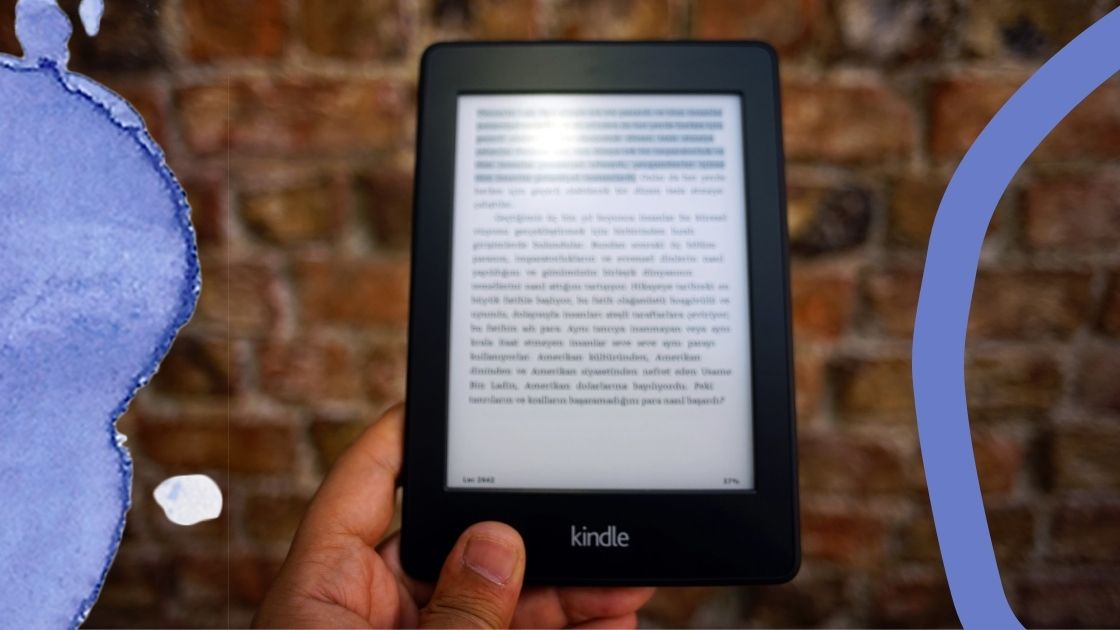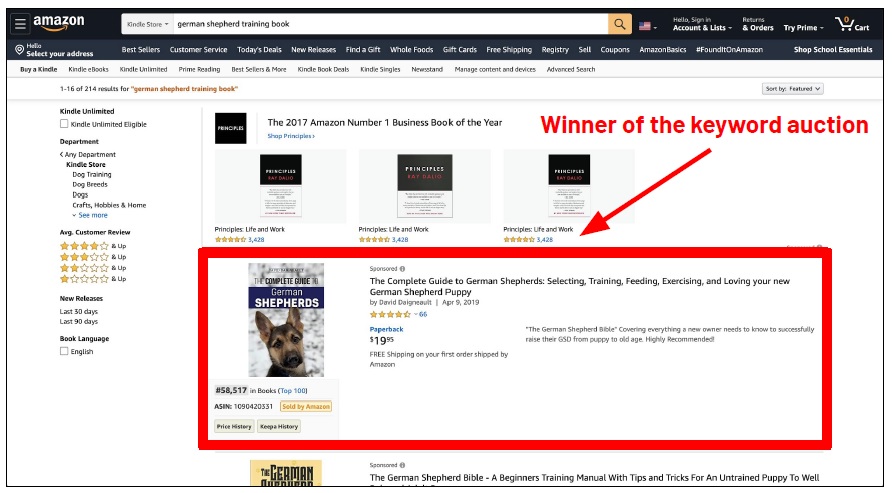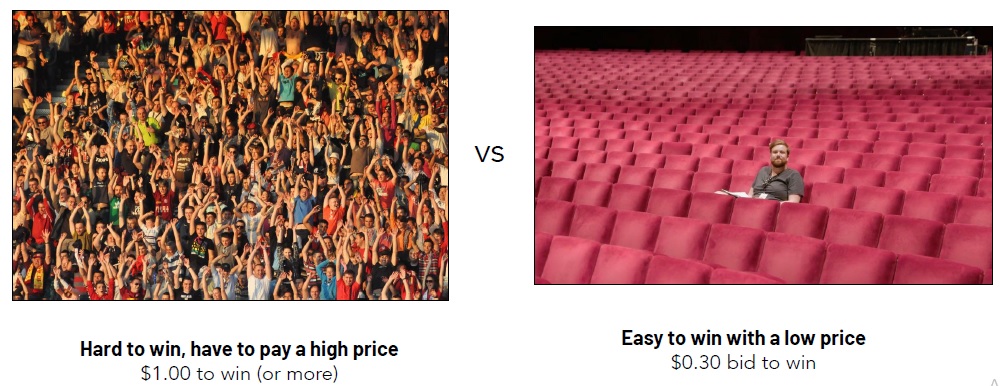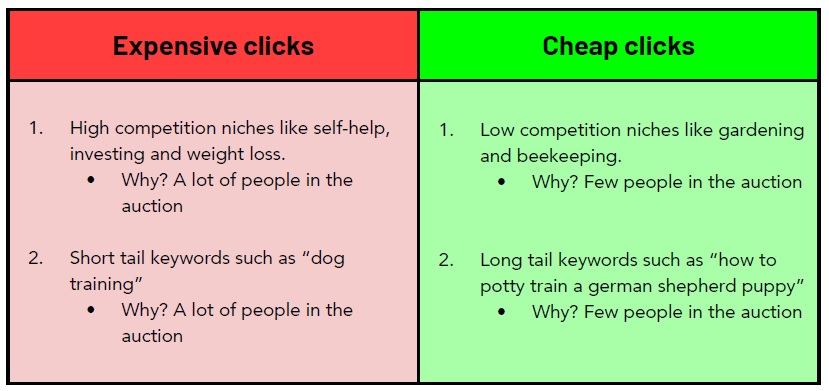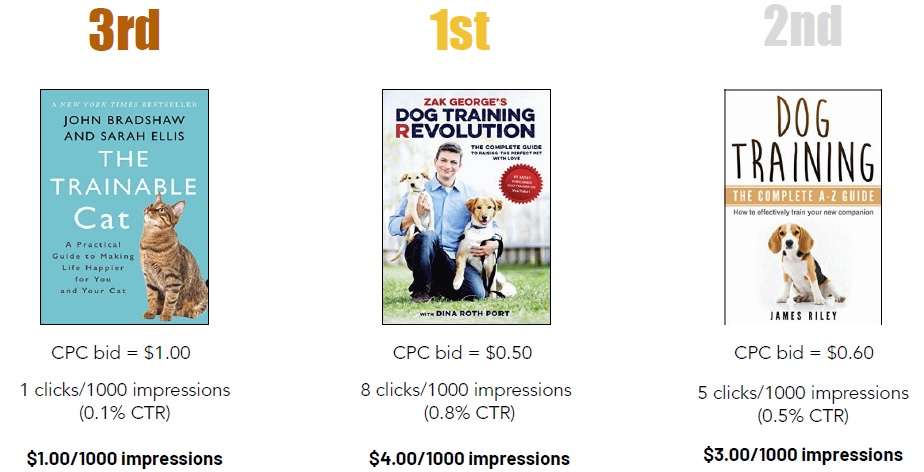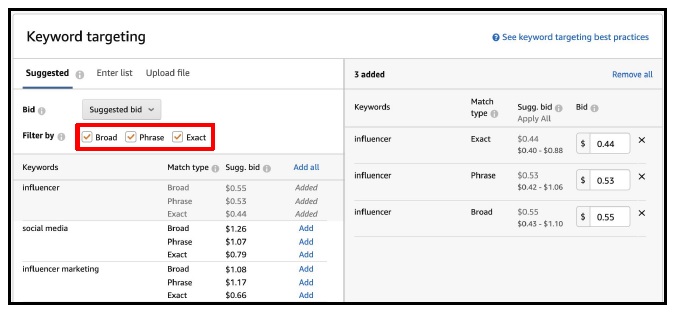Amazon Ads Bidding System
Amazon uses a keyword bidding system to determine who’s ads get shown on Amazon. Every time someone searches something in Amazon, a keyword auction is conducted in milliseconds by Amazon’s algorithm to determine who’s ads get shown and where.
The entire Amazon Ads platform revolves around bidding for keywords. So it’s really just a game of finding what keywords you want to bid on and how much you want to bid on them.
It’s not as complicated as people make it out to be. Running the Amazon book Ads is not the hard part, it’s actually super simple and easy when you learn it.
Let’s look at an example of a keyword auction in action.
- Keyword that is being bid on: German shepherd training book
- Auction depends on the Competition
- Amazon Ads are very niche dependent
- Go after long tail keywords as they are cheap and they convert into sales
The Amazon bidding system takes more than just your bid price into account when deciding which ads to show. Your bid price is just one factor in the equation.
Therefore, being the highest bidder does not mean you will win your keyword auctions. It also means that increasing your bid does not guarantee that your ad will receive more impressions.
In the end, Amazon cares about making the most money. Showing the ad with the highest bid will not always make them the most money because the ad still needs to be clicked on.
If the book is unattractive or irrelevant, then no one will click on the ad and Amazon won’t make money. Ads for bad books don’t get clicks, so Amazon won’t show your ad unless you bid really high.
If you struggle to get impressions, it’s because Amazon doesn’t like your book because people don’t click on it and buy. This is why CTR really matters.
What makes an ad attractive, and thus produces a high CTR?
1. Review -. When you have 50+ good reviews, you will dominate.
2. Cover – Your cover needs to noticeably stand out from the rest.
3. Title – You want a title makes people feel like “I NEED THIS BOOK”.
4. Relevance – Running ads to irrelevant keywords is just pointless.
Let’s look at an example… All these books are bidding for the keyword “dog training”
So how do you get preferred treatment by Amazon and win your auctions? GET CLICKS on your ads.
So having better & more reviews, a better cover and a better title is going INCREASE your impressions while DECREASING your CPC and improving your overall ads performance.
Again, The performance of your ads is ALL ABOUT YOUR BOOK. The ads strategy is simply there to make the most of your ads.
Test. Scale. Optimize ( TOS Method )
The T.S.O Method is an Amazon book Ads strategy that is used to, simply put, make the most money humanly possible from your Amazon Ads by finding the best keywords to bid on.
No fluff, no BS, no complicated nonsense, just profit from your ads and lots of it.
1. Test: Create 2 test campaigns (per book)
- Goal: Find keywords that produce sales and profit (winning keywords)
2. Scale: Put your winning keywords into a new scaling campaign
- Goal: Scale winning keywords
3. Optimize: Optimize your campaigns
- Goal: Make your campaigns more cost efficient and profitable
Step 1: Test
It is impossible to know what your best converting/winning keywords will be without testing it.
Any Amazon ads strategy that doesn’t first involve testing a bunch of keywords is flawed from the start. The purpose of the testing stage is to “cast a wide net” by bidding on thousands of different keywords and using that data to find your winners (that you scale) and your losers (that you turn off).
The best keyword research tool is always going to be REAL DATA.
Start by creating 2 test campaigns: 1 auto test campaign + 1 manual test campaign
2 kinds of campaigns:
1. Auto campaign – Amazon looks at your book and bids on thousands of relevant keywords for you. By far the best for long-tail keyword discovery.
2. Manual campaign – You pick the keywords you want to target. Select 5-10 broad and phrase keywords from amazon’s autosuggestions.
These 2 test campaigns are going to bid on a bunch of different keywords and will give us all the real world data we need to create a scaling campaign that will crush it.
These test campaigns should run indefinitely and never be turned off. Testing is a never-ending process.
KW Match Types : Broad vs Pharse vs Extract
1. Broad keywords: Targets keyword + synonyms, variations and related keywords (Test)
2. Phrase keywords: Targets keyword + all search terms/phrases that include the keyword (Test)
3. Exact keywords: Targets only the exact keyword + the plural (Scale)
Step 2: Scale
Move your winning keywords from your test campaigns into a new campaign that is designed for scaling. This campaign will be made up of exact keywords.
Your scaling campaign allows you to focus and use all of your campaign’s budget on the keywords that are proven to make you sales. Spend more money on what works.
Your auto campaign may only spend $5 out of $20/day on winning keywords. But when you move your winning keywords to a scaling campaign, you can spend all $20/day budget on your winners.
In your scaling campaign, you can increase your budget and your bids so you can get a lot of impressions and exposure for your winning keywords. This is the money making campaign. Your test campaigns likely won’t be very profitable until you optimize them.
What makes a Keyword a Winner?
A winning keyword is one that gets 2 conversions at a 50% ACoS or better. This means the keyword is profitable and worth focusing attention and budget on.
In a perfect world, you would want a lot more conversions and data to truly know if a keyword is a true winner but this is what you have to do when you are working with a small sample size.
If we have 1000 conversions, we would know exactly which are our best keywords. But when you only have 10-20 conversions, you can only do your best with what you have. Finding your winning keywords might take you weeks or even months depending on your budget.
Step 3: Optimize
Step 3 is to optimize your test campaigns and your scaling campaign. Optimize simply means to make your campaigns more lean and efficient so you don’t waste any money.
Optimize your test campaigns with Negative keyword optimization
- Stop bidding on losing keywords to stop the bleeding.
- Stop bidding on winning keywords (it’s no longer a test keyword so remove it)
How to optimize your scaling campaign with Bid optimization
- Adjust bids by looking at ACoS. Every winning keyword should be bid optimized
- If keyword is performing well (30% ACoS) and you want more impressions, increase the bid by $0.05 to $0.10.
- If keyword is performing above 50% ACoS, decrease the bid. This will lowerimpressions but it will also lower CPC and thus get your ACoS closer to 30%
Negative Keywords to Optimize your Test Campaigns
Negative keywords prevent your ads from showing when a shopper’s search term matches your negative keyword. Negative keywords are a great way to optimize your ad spend and stop spending on bad keywords that you don’t want to show up for.
You can add negative exact keywords and negative phrase keywords.
1. Negative Exact: Cat. You will never show up for the search term cat (and cats).
2. Negative Phrase: Cat. You will never show up for ANY search term with cat in it.
You should add obvious negative phrase keywords to a test campaign from the start, if applicable.
When to Start with Negative Phrases
1. If you sell cat training to cat owners, you can confidently add “dog” as a negative phrase keyword so that you will never ever show up when someone is searching for dog books.
2. If you sell anything to adult women, you can confidently add “men” and “kids” as negative phrase keywords so that you will never ever show up for anything when someone is searching anything “for men” or “for kids”.
Most negative keywords will be added to your test campaigns based on the data, but you should add obvious negative phrase keywords to begin with if it makes sense.
If you sell general yoga books, But if you only sell yoga for kids, you can add “adults” and “seniors” as negative phrase keywords because you know it will be a waste of money.
Check more articles:
10 Best Amazon FBA Course ( Six-Figure Business )
How to Dropship on Amazon Step by Step – Complete Guide
How To Use YouTube Ads For Amazon FBA
How to Optimize Amazon Book to Increase Conversion Rate
Conclusion
When you use Amazon Advertising to target your ideal readers, you have the ability to achieve incredible results. It is not necessary to worry about sales if you could somehow get your book in front of the Correct readers, people who are actively searching for books just like yours.
Consider Following a Course ?
With Lifetime Access ?
We have been the number 1# platform for delivering most demanding course. Becoming Lifetime Member , You will receive all the Premium content For FREE

Consider Following a Course ? With Lifetime Access ?
We have been the number 1# platform for delivering most demanding course. Becoming Lifetime Member , You will receive all the Premium content For FREE

